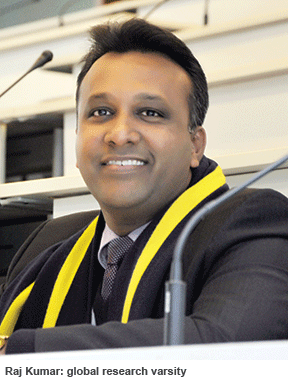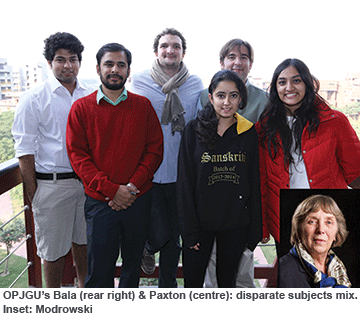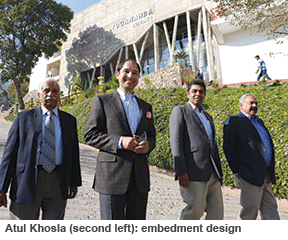India’s liberal arts renaissance
Suddenly almost out of the blue, a clutch of private edupreneurs have negotiated forbidding and grudging licensing processes to establish several globally benchmarked liberal arts universities across the country. Dilip Thakore reports
 AFTER MANY YEARS IN exile on the periphery of national consciousness, a liberal arts education renaissance is sweeping the country. This is manifested not only in the large crowds thronging the multiplying number of literary festivals featuring promising new writers in all languages, especially English, but also in the promotion of a number of new genre American-style private universities with strong, and even predominant, liberal arts schools/faculties nationwide.
AFTER MANY YEARS IN exile on the periphery of national consciousness, a liberal arts education renaissance is sweeping the country. This is manifested not only in the large crowds thronging the multiplying number of literary festivals featuring promising new writers in all languages, especially English, but also in the promotion of a number of new genre American-style private universities with strong, and even predominant, liberal arts schools/faculties nationwide.
Since independence the number of colleges and universities countrywide has increased from 500 and 20 in 1947 to 35,000 and 700 in 2013 with an impressive aggregate enrolment of 20 million undergrad and postgraduate students. Moreover the number of private universities has increased to 140, despite the government-run higher education supervisory and regulatory authorities being hostile to private initiatives in tertiary education.
But in the first flush of freedom when massive heavy industry and nation-building projects were initiated to make good stagnation of free India’s economy which had averaged a growth rate of 1 percent per annum during almost 200 years of foreign rule, the national focus was on science and technology education. Ambitious and capital-intensive institutions such as the Indian Institute of Science, Indian Institutes of Technology, National Institutes of Technology and Indian Institutes of Management basked in the limelight of national attention while liberal arts education — mainly provided by Central and state government aided missionary colleges and universities — received short shrift.
In the circumstances, it’s hardly surprising that the overwhelming majority of private colleges and universities such as Manipal, Vellore Institute of Technology, Hindustan University, PSG Group among others, concentrated on providing utilitarian professional education (engineering, medicine, hotel and business management) programmes. Liberal arts education, especially the study of subjects such as English and Indian literature, history, geography and the social sciences, were relatively neglected. Until very recently liberal arts classes in higher education tended to be crowded with youth who had failed to pass the more rigorous and demanding entrance exams of engineering and medical colleges.
“There hasn’t been neglect of liberal arts education in terms of recognition of degrees or establishment of programmes — the largest proportion of undergraduates are in the arts. The neglect has been in terms of failure to sustain the quality of liberal arts study programmes. In the 1950s and 60s, several internationally renowned scholars were enrolled in Indian universities for doctorates in Sanskrit, philosophy and history. However, over the years, these programmes lost their stature substantially. The sorry state of the universities of Allahabad, Mysore, Madras, and Baroda are good examples. Great scholars and scholarship had emanated from these universities which have suffered steep decline,” says Dr. A.R. Vasavi, senior fellow at the Nehru Memorial Museum and Library, Delhi, who was awarded the Infosys Prize for social sciences — sociology and anthropology — in 2013.
According to Dr. Vasavi, the fallout of Indian academia’s failure to upgrade liberal arts education and especially the social sciences, is “a general decline in the quality of intellectual debates and in the ability of persons to understand important cultural and social issues… resulting in a public discourse that is poor in orientation, distorted in perspective, and problematic in the impact it has on inter-group relationships in a multicultural nation”. “In privileging science and technology education/training over comprehensive knowledge, there’s been a tendency to regard natural scientists and technologists as the best guides for resolving the nation’s problems. The iconisation of scientists is only a part of this problem. The larger problem of the deliberate oversight and neglect of social sciences, is thinking for and about the nation. This is reflected in the paradox that it is easier to send a mission to Mars than to universalise sanitation,” she says.
Indeed post-independence India has paid a heavy price for ignoring liberal arts education. With rigid and too-early streaming into arts, science and commerce — a defining feature of the Indian education system — important positions in government, administration and corporate organisations have tended to be monopolised by narrowly specialised, technically qualified professionals with insufficient grounding in history, geography, philosophy, culture, law, governance and citizenship. In this context it’s pertinent to note that India’s most powerful prime ministers — Jawaharlal Nehru (natural sciences), Indira Gandhi (lapsed liberal arts student), Rajiv Gandhi (commercial pilot’s licence), and de facto prime minister Sonia Gandhi (school-leaver) — who took the nation down roads to disaster, were insufficiently schooled in the liberal arts. Post-independence India’s most successful prime minister who freed the country from the debilitating yoke of socialism, was the late Narasimha Rao, a litterateur and linguist.
The disastrous socio-economic consequences of continuous devaluation of the humanities — which develops the aesthetics, cultural sensitivity and refinements of children and youth — are ubiquitous. It is manifest in the country’s ugly public buildings and spaces, the raucous and aggressive behaviour of youth in tertiary education and intemperate and uncivil conduct of ill-educated representatives of the people in Parliament and state legislatures. Meanwhile demand in industry and academia for well-educated liberal arts graduates has exploded. Salaries and remuneration packages of psychologists, HRD managers and communications professionals are sky-high.
Fortunately even if belatedly, there’s growing awareness of the value of liberal arts education within the public and in particular among citizens and members of the Indian diaspora who have studied and lived abroad in the UK and US, where universities respect and nurture their liberal arts and cultural traditions. Indeed, right now as the emerging new global economy assumes shape and form, the long-promised ‘reverse brain drain’ — emigre Indians of the diaspora — bringing the knowledge, technology and knowhow of the West to the country of their origin — is beginning to positively impact Indian education, and liberal arts education in particular. (see box p.60)
Suddenly, almost out of the blue, a clutch of private edupreneurs bypassing the forbidding and grudging licensing and regulatory processes of the Union ministry of human resource development and University Grants Commission, have taken advantage of the discretionary power of state governments to promote and establish liberal arts universities — under the Constitution education is a concurrent list subject with both the Centre and states permitted to enact enabling legislation — across the country. Among them: O.P. Jindal Global University in Sonipat, Haryana (estb. 2009); Azim Premji University, Bangalore (2010); Ashoka University, Sonipat, Haryana, (2014) and Shasun School of Liberal Education, Chennai (2014).
Perhaps taking a cue from these initiatives, even the Union and Bihar state governments enacted the Nalanda University Act, 2010, under which they have commenced re-construction of ancient India’s Nalanda University which will have a strong liberal arts focus. With an estimated initial project cost of US $500 million (Rs.3,000 crore), the university is sited on a 443 acre under-construction campus in Rajgir, Bihar, 11 km from the ruins of the classical University of Nalanda — in its time (5th century AD) the world’s largest institution of higher education.
 The fledgling Nalanda admitted its first batch of 15 undergrad students, housed in temporary accommodation in Rajgir, into its pioneer ancient history and ecology and environment degree programme last August. Ideated by economics Nobel laureate Dr. Amartya Sen, its first chancellor, driver and fund-raiser (the governments of Japan and Singapore have committed to contributing $100 million (Rs.600 crore) each towards the cost of construction), Nalanda University is the most ambitious and capital-intensive education project in the history of post-independence India.
The fledgling Nalanda admitted its first batch of 15 undergrad students, housed in temporary accommodation in Rajgir, into its pioneer ancient history and ecology and environment degree programme last August. Ideated by economics Nobel laureate Dr. Amartya Sen, its first chancellor, driver and fund-raiser (the governments of Japan and Singapore have committed to contributing $100 million (Rs.600 crore) each towards the cost of construction), Nalanda University is the most ambitious and capital-intensive education project in the history of post-independence India.
“The resurrected Nalanda will be a fully-fledged multi-disciplinary university with a strong focus on the liberal arts and social sciences. One of our prime objectives is to break down the system of confining students to disciplinary silos. We intend to design our own academic programmes in which there will be numerous cross-posted courses enabling students to choose combinations of subjects across divergent disciplines and faculties. Students will learn inside and outside classrooms through hands-on activities with research work woven into the curriculum. Moreover Nalanda will be a truly international university with an internationally respected faculty and students from around the world,” promises Dr. Gopa Sabharwal, an alumna of the Delhi School of Economics, who established the sociology department of Lady Shri Ram College, Delhi in 1993. In 2011, Sabharwal was appointed the revived Nalanda University’s first vice chancellor after she was hand-picked by a committee chaired by Dr. Sen, to get this ambitious new varsity off the ground and earn a place of honour in the history of Indian education.
Although Nalanda, which aspires to recapture and recreate the glory of 5th century India when its eponymous predecessor was an epicentre of higher learning and attracted students from all over the world, is the most ambitious of India’s liberal arts focused nexgen universities, it’s still a tiny speck on the distant horizon. Meanwhile the imagination of Indian academia and the discerning public has been captured by the mint new Ashoka University (AU) — India’s first exclusively liberal arts university — which admitted its first batch of 133 students on September 1 last year.
Sited on a 25-acre campus in the Rajiv Gandhi Education City in Sonipat, Haryana in the Delhi NCR (national capital region), AU has generated great excitement within Indian academia and the aspirational new middle class which unlike the traditional post-independence middle class, accords great importance to high quality, globally benchmarked liberal arts higher education.
Already, within months of the university starting its first classes, it has spearheaded several unprecedented initiatives which could revolutionise India’s stagnant and moribund higher education system. First, it’s perhaps the country’s first wholly — American Ivy league-style — liberal arts university. Secondly, it’s entirely crowd-funded with more than 50 philanthropists, businessmen and well-wishers having paid up and/or having committed substantial amounts for its construction and operationalisation. And fittingly in the emerging globalising world, under its charter Ashoka is an international university which will have a generous mix of Indian and foreign students and faculty.
“At a time when India is beset with great problems and challenges — massive income inequality and huge deficits in education, health, employment, environment preservation and national security — we need to develop our brightest minds to engage with them. Provision of liberal multidisciplinary education is the best way we can train bright young minds to engage with these issues. India needs many universities like Ashoka so that parents don’t have to spend their entire savings sending children abroad and outsource higher education to developed nations. This is the motivation behind the promotion of Ashoka University, which we hope will serve as a model for several similar universities. Except for a few islands of excellence, India’s higher education system is plagued by poor quality. I believe we owe it to our youth to give them the very best education, comparable to any worldwide. ISB (Indian School of Business, Hyderabad) has proved it can be done and now  Ashoka will do the same,” says Pramath Sinha, an alumnus of IIT-Kanpur and University of Pennsylvania and founder- trustee of AU. Currently promoter-director of the Delhi-based 9.9 Mediaworxx Pvt. Ltd, Sinha, a former partner of the New York-based McKinsey & Co and founder-dean of ISB (estb. 2001), which at #13 outranks all Indian B-schools in the Financial Times, London’s annual league table of the world’s best B-schools, brings a formidable arsenal of institutional and business management experience and expertise into Ashoka University.
Ashoka will do the same,” says Pramath Sinha, an alumnus of IIT-Kanpur and University of Pennsylvania and founder- trustee of AU. Currently promoter-director of the Delhi-based 9.9 Mediaworxx Pvt. Ltd, Sinha, a former partner of the New York-based McKinsey & Co and founder-dean of ISB (estb. 2001), which at #13 outranks all Indian B-schools in the Financial Times, London’s annual league table of the world’s best B-schools, brings a formidable arsenal of institutional and business management experience and expertise into Ashoka University.
Indeed, an outstanding characteristic of the Ashoka project is the large number of highly-qualified and accomplished individuals with extraordinary track records in business, industry and finance, that it has attracted as donors and supporters. The list of 14 founder-trustees — individuals who have endowed more than Rs.5 crore to the International Foundation for Research and Education — under whose aegis South Asia’s exclusively liberal arts university is being shaped and constructed — reads like a Who’s Who of the new post-liberalisation economy. Among them: Sanjeev Bikhchandani (naukri.com); investment guru Rakesh Jhunjhunwala; Puneet Dalmia (Dalmia Cements); Anil Rai Gupta (Havell’s India); Vineet Gupta (Jamboree Education); Kapil Kapoor (Caldera Pacific Capital Partners); Atul Nishar (Hexaware); Siddharth Yog (Xander Group); Pramath Sinha (introduced above) and Ashish Dhawan (ChrysCapital and Central Square Foundation).
This is the largest ever collective philanthropy initiative in the history of Indian education, and has aroused great enthusiasm within leaders of Indian industry and the Indian diaspora who have a strong latent will to aid and enable Indian education. But donors want top-notch execution skills and highest levels of integrity. The Ashoka University project offers them not just that but also the once-in-a-lifetime opportunity to become the founders of a new Harvard or Yale being shaped in India. We already have 50 founders, and have raised Rs.300 crore from a large number of first generation entrepreneurs in the 30-50 age group.
We’ve just begun our international road shows in Singapore and already have three donors from there. There is a huge interest in the AU initiative in the US, Hong Kong and Singapore. I am confident that we will raise the Rs.500 crore required to complete the project within the next year itself against the targeted three years,” says Ashish Dhawan, the Yale and Harvard educated former senior partner of ChrysCapital Advisors (India’s first major venture capital company), promoter-chairman of the Central Square Foundation (estb. 2012; corpus: Rs.50 crore) and founder-trustee of AU, who is this nexgen varsity’s chair of the board of trustees and chief evangelist and fund raiser.
The AU project has aroused unprecedented excitement within the cognoscenti in India and abroad not only because of the movers and shakers of business, industry and finance backing the initiative, but also because the project is being implemented in several parallel streams — fund raising, campus construction, faculty recruitment and curriculum development — simultaneously, and with impressive urgency. Therefore, despite the Indian educracy’s notorious red tape which has strangled numerous enterprises of great pith and moment, the founder-trustees and the go-getting project management team assembled by them have succeeded in completing the first phase of construction, while recruiting excellent faculty which has expeditiously designed innovative curriculums enabling the admission of 133 carefully selected undergraduate, and 197 fellowship (Masters) students who began classes on September 1.
Getting the dozens of regulatory approvals from government(s) and layers of supervisory authorities, pushing enabling legislation through the Haryana state assembly and fast-tracking construction work on the campus, were tasks voluntarily undertaken by Vineet Gupta, an alum of IIT-Delhi, co-founder of Parabolic Drugs Ltd, promoter-director of the Delhi-based Jamboree Education Pvt. Ltd (a GMAT, SAT, GRE tests preparation company) and founder-trustee of AU. “Pranav Gupta, co-founder and CEO of Parabolic Drugs, Rakesh Jaggi, president Schlumberger, Ashish Gupta, COO of Evalueserve — all founders and trustees of AU — and I linked up with Ashish (Dhawan), Sanjeev (Bikhchandani) and Pramath (Sinha) to assist with the Ashoka University project in 2007. To fast-track the project I accepted the position of pro vice chancellor to head all non-academic implementation and administration activities. With the Rs.150 crore already raised and after appointing 300 sub-contractors, we have been able to complete 300,000 sq. ft of the 1.4 million sq.ft built-up area which the university will have on completion of construction in 2019. After speedy recruitment of 144 employees we have been able to admit our first batch of 330 students into this wholly residential university and get classes started,” says Gupta with evident satisfaction.
Parallely, the academic team headed by nationally reputed former Delhi University sociologist Dr. Andre Beteille (chancellor) and vice chancellor Dr. Rudrangshu Mukherjee, has speedily assembled 15 full-time and 39 visiting faculty after global scouting for best talent.
“We have been able to quickly attract an excellent faculty of resident and visiting professors from India and abroad who have helped develop the culture, admin systems, curriculum, pedagogies and assessment framework in alignment with the institutional development vision and objectives of the founder-trustees of Ashoka University. Our first batches of 133 undergraduate and 197 postgrad students who will complete their first semester shortly, are very bright and able. The Indian economy and society urgently need well-educated professionals and entrepreneurs with broad education and good communication skills. I believe AU graduates will fulfil this need,” says Mukherjee who read history at Presidency College, Kolkata, JNU, Delhi and Oxford University, taught the subject in Calcutta University (1981-93), was visiting professor at Princeton and Manchester universities and served as the editor of the editorial and op-ed pages of The Telegraph, Kolkata (1993-2014) — during which period it was established as the most widely-read English language daily in Eastern India — prior to accepting the challenge to serve as AU’s first vice chancellor early last year.
 The rigorous liberal arts curriculum designed for AU undergrad and postgraduate students is detailed by Dr. Jonathan Gil Harris, an English and philosophy alum of Auckland (New Zealand) and Sussex (UK) universities with teaching and research experience in Ithaca College (1990-2003), and George Washington University (2003-13), USA. In the first two years of the undergrad programme, all students have to take 12 foundational courses. They are obliged to sharpen their critical thinking (logic, communication, versatility, ethics of empathy, teamwork and intelligent argument basics) in the first semester (four-and-half months), followed by seminars on critical thinking led by the faculty in the second. In the second year, all undergrads compulsorily study literature and the world, trends in history, philosophy and psychology, economics and political science, maths, principles of science and Indian civilisations. In the third year, they choose a major and minor from among nine core subjects (English, history, economics, philosophy, sociology, maths, PPE (politics, philosophy, economics) and media studies).
The rigorous liberal arts curriculum designed for AU undergrad and postgraduate students is detailed by Dr. Jonathan Gil Harris, an English and philosophy alum of Auckland (New Zealand) and Sussex (UK) universities with teaching and research experience in Ithaca College (1990-2003), and George Washington University (2003-13), USA. In the first two years of the undergrad programme, all students have to take 12 foundational courses. They are obliged to sharpen their critical thinking (logic, communication, versatility, ethics of empathy, teamwork and intelligent argument basics) in the first semester (four-and-half months), followed by seminars on critical thinking led by the faculty in the second. In the second year, all undergrads compulsorily study literature and the world, trends in history, philosophy and psychology, economics and political science, maths, principles of science and Indian civilisations. In the third year, they choose a major and minor from among nine core subjects (English, history, economics, philosophy, sociology, maths, PPE (politics, philosophy, economics) and media studies).
“Our interactive curriculum grafts the best Western pedagogies and practice with Indian culture and civilisation. I’m confident that every Ashoka graduate will be a persuasive speaker, good writer, listener and ethically engaged teamworker,” says Harris.
It’s also pertinent to note that its numerous breakaway characteristics — crowd-funding, wholly residential (to provide students an immersive liberal arts education experience), unprecedentedly broad-based curriculum, international profile, life skills development focus — apart, AU is a relatively high-priced university. Unlike most liberal arts colleges which levy universally subsidised tuition charges, AU prescribes high tuition fees (Rs.4.85 lakh per year inclusive of twin-sharing residential accommodation) by Indian standards. However scholarships are liberally dispensed after means-testing students with over 60 percent of the first batch granted partial or full scholarships. “The institutional objective is to ensure that no meritorious student is denied admission for lack of finance. In the initial years we expect tuition fees to cover at least 50 percent of expenses and as our endowment corpus grows, the interest thereon will transform AU into a needs-blind university,” explains Ashish Dhawan.
Although the newly conceptualised Nalanda and Ashoka universities with their high-profile promoters and articulate spokespersons have excited and captured the attention of the discerning public, credit for establishing the country’s first new genre liberal arts higher education institute must be given to (unrelated) visionaries Nemish Shah (promoter-chairman of the Mumbai-based merchant banking firm Enam Financial Consultants) and Pune-based serial entrepreneur Parag Shah (promoter of Snap Marketing Pvt. Ltd (vending machines) and Oxford Realty) who promoted the Foundation for Liberal And Management Education (FLAME) Academy in 2007. Sited on a 75-acre campus amidst undulating hills and the verdant countryside of Lavale village, Taluka Mulshi, near Pune, FLAME admitted its first batch of 108 business management students in 2007. After that it rapidly added the FLAME schools of liberal education, communication, and performing arts to its pioneer business school.
Affiliated with the Bharati Vidyapeeth University, Pune, FLAME has an aggregate enrolment of 560 students (of whom 55 percent are women) mentored by a 61-strong faculty supplemented by 20 visiting faculty. India’s first low-profile liberal arts college was promoted under the aegis of the FLAME Foundation (regd. 2004), out of the founder-trustees’ “strong reaction against the rigidity, aridity and empty formalism of a syllabus bound educational system”.
“The distinguishing feature of FLAME education is that all curriculums are heavily supplemented by social science, humanities, international languages and a plethora of life skills and experiential programmes to develop self-learning and collaborative learning skills of students. Our objective is to nurture and develop well-rounded graduates with professional and life skills, who are also invested with ethical and good citizenship values,” says Dr. Indira Parikh, an alumna of INSEAD (Paris) and Rochester University (USA) and former professor at IIM-Ahmedabad for over a quarter century, who signed up with the foundation in 2006 and is currently the head of academics and president of FLAME Academy.
The FLAME Academy initiative and rising awareness of the beneficial socio-economic impact of hitherto neglected liberal arts education, has prompted the promotion of several other high-potential liberal arts private colleges/universities countrywide. A short (11 km) drive from the Ashoka University campus and within the limits of Haryana’s Rajiv Gandhi Education City, is the huge, capital-intensive O.P. Jindal Global University (OPJGU). Enacted by special legislation of the Haryana state government in 2009, OPJGU is sited on a 100 acre estate campus with a massive steel and glass encased built-up area of 922,819 sq ft. Promoted by Naveen Jindal, chairman of Jindal Power & Steel Ltd (annual revenue: Rs.18,900 crore) and a former member of Parliament in memory of his father, the university constructed at a cost of Rs.600 crore, comprises five schools — law, business, international affairs, governance and public policy and liberal arts and humanities. Thus far OPJGU has graduated 385 — mainly law and business management — students.
 The vision of JGU is to promote global courses, global programmes, global curriculums, global research, global collaborations, and global interaction through a global faculty. JGU is a research intensive university, which has established research centres in all its schools and all faculty appointments are made on the basis of appointment to a school as well as a research centre,” says Dr. C. Raj Kumar, the youthful founder vice chancellor of OPJGU. A highly qualified commerce and law graduate of Loyola College, Chennai, Delhi University, Oxford, Harvard and Hong Kong universities, Raj Kumar acquired major teaching and research experience at the School of Law of City University, Hong Kong, prior to being appointed founding vice chancellor of OPJGU after a worldwide search, in 2009.
The vision of JGU is to promote global courses, global programmes, global curriculums, global research, global collaborations, and global interaction through a global faculty. JGU is a research intensive university, which has established research centres in all its schools and all faculty appointments are made on the basis of appointment to a school as well as a research centre,” says Dr. C. Raj Kumar, the youthful founder vice chancellor of OPJGU. A highly qualified commerce and law graduate of Loyola College, Chennai, Delhi University, Oxford, Harvard and Hong Kong universities, Raj Kumar acquired major teaching and research experience at the School of Law of City University, Hong Kong, prior to being appointed founding vice chancellor of OPJGU after a worldwide search, in 2009.
Quite clearly, as indicated by its institutional profile, the focus of this high-potential university which has ventured into new areas of scholarship and research, is liberal arts education, an emphasis underscored by the promotion of its dedicated school of liberal arts and humanities which admitted its first batch of 20 students last year.
“We offer the only transnational liberal arts programme in India with students spending two years in an intensive accelerated learning programme in OPJGU followed by one year in Rollins College, Florida — one of America’s top-ranked liberal arts colleges — and an optional second year at Rollins for a dual degree. The differentiating feature of JSLH (Jindal School of Liberal Arts and Humanities) is our strong emphasis on experiential learning with internships mandatory after the first semester.
This is not solely for career preparation; the internship programme is credit-bearing and uses the host organisation as a location of study and research, independently of skills students acquire on the job. Moreover courses in JSLH are inter-disciplinary and could connect history with classes in philosophy, literature and field trips to historical sites,” says Kathleen Modrowski, an alumna of the University of Toledo, USA, and EHESS — School for Advanced Social Sciences, Paris — who acquired 25 years of experience conceptualising, researching and teaching global studies and experiential learning programmes at the Global College of Long Island University, USA before being appointed dean of JSLH last year.
could connect history with classes in philosophy, literature and field trips to historical sites,” says Kathleen Modrowski, an alumna of the University of Toledo, USA, and EHESS — School for Advanced Social Sciences, Paris — who acquired 25 years of experience conceptualising, researching and teaching global studies and experiential learning programmes at the Global College of Long Island University, USA before being appointed dean of JSLH last year.
The breadth of JSLH’s liberal arts programme is also indicated by its choice of faculty. Sean P. Bala, who teaches philosophy and communicative writing, combines these subjects with world history and theatre. A comparative religions graduate of the Harvard School of Divinity with a Masters from the Divinity School of Chicago, he intends to add religious studies to the disparate mix of subjects he teaches next year. “Excellent liberal arts education is necessarily inter-disciplinary, and society needs people who can discuss religion intelligently and balance religion with modernity,” says Bala.
Adds Cameron Paxton, a history graduate of Michigan State University with a Masters in political science from Chicago University, who teaches history, political science and sociology at JSLH: “Contemporary curriculums need to focus on global themes to prepare students for the emerging globalised world.”
Encouragingly, the importance of infusing all higher education programmes with liberal arts education to produce balanced graduates with awareness of socio-economic realities and good communication and other life skills, has begun to spread beyond metropolitan India into tier-II and tier-III cities, mainly because of the return of professionals of the Indian diaspora after the liberalisation and deregulation of the autarkic Indian economy in the 1990s.
 A case in point is Shoolini University, sited on the Oachghat-Kumarhatti Road, 15 km from Solan (Himachal Pradesh), and promoted by Dr. Prem Khosla, former vice chancellor of the H.P. Agricultural University as the Shoolini Institute of Science & Biotechnology in 2004 with an investment of Rs.20 lakh. Following the return of his son Atul, an alum of IIT-Kanpur and the Jamnalal Bajaj Institute of Management Studies, Mumbai, who was signed up by McKinsey & Co, New York in 1995 and returned to India in 2002, the institute has not only been upgraded to university status by a special Act of the H.P. legislature, it has added a strong liberal arts school to its biotech and natural sciences, business management sciences, engineering and technology and pharmacy faculties.
A case in point is Shoolini University, sited on the Oachghat-Kumarhatti Road, 15 km from Solan (Himachal Pradesh), and promoted by Dr. Prem Khosla, former vice chancellor of the H.P. Agricultural University as the Shoolini Institute of Science & Biotechnology in 2004 with an investment of Rs.20 lakh. Following the return of his son Atul, an alum of IIT-Kanpur and the Jamnalal Bajaj Institute of Management Studies, Mumbai, who was signed up by McKinsey & Co, New York in 1995 and returned to India in 2002, the institute has not only been upgraded to university status by a special Act of the H.P. legislature, it has added a strong liberal arts school to its biotech and natural sciences, business management sciences, engineering and technology and pharmacy faculties.
“Although we are primarily a professional education institution with a strong focus on science and biotech education, in a departure from the general practice in colleges/universities of professional education, from 2008 when the Shoolini Institute was conferred university status, we have embedded liberal arts subjects including basic economics, sociology, philosophy, English and Hindi literature in all study programmes. In 2015 we will start our liberal arts school which will provide formal undergrad and postgraduate programmes in English, economics, philosophy and environment and ecology studies with special focus on Himalayan sustainability. Shoolini has been deliberately positioned as an affordably priced (tuition fee: Rs.1-1.5 lakh per year) university for students of tier-II and tier-III cities and towns. Despite this, we are a research oriented university with 400 of our 3,000 students engaged in doctoral research. We have set ourselves the goal of being ranked among the world’s Top 200 universities in the next ten years,” says Atul Khosla.
Awareness of the salutary outcomes of liberal arts studies is also beginning to dawn in peninsular India, which hosts 70 percent of the country’s engineering colleges and nationally — and perhaps even internationally — renowned professional education universities such as Manipal, VIT, Vellore, SRM, and Hindustan among others, which attract would-be engineers, medical practitioners, animators, pharmacists and business managers from across the country and abroad. Last July, the Shasun School of Liberal Education (SSLE), an all-women college promoted by the Chennai-based S.S. Jain Educational Society which manages five schools and two colleges in Chennai, admitted its first batch of 11 students mentored by five full-time and 20 visiting faculty, into its integrated business, psychology and visual communications undergrad programme. .gif)
SSLE is the first college in south India to offer specially designed liberal arts courses for women. Our objective is to empower and prepare them to assume leadership roles in society by providing holistic education which combines the ancient knowledge and culture of India with best global education practices and pedagogies to enable women to meet the constantly changing challenges of the future,” says S. Abhaya Kumar, the founder-managing director of the Chennai-based Shasun Pharmaceuticals Ltd (annual revenue: Rs.935 crore), and managing trustee of the S.S. Jain Educational Society which ventured into education in 2004, with the promotion of the Sundarbai Shasun Jain College for Women, Chennai which currently has an aggregate enrolment of 3,600 women students mentored by 142 faculty.
Undoubtedly the neglect and middle class and establishment disregard for liberal arts education for over half a century, has cost the country dear in terms of poor quality of public debate and discourse and academic failure to rediscover pre-colonial India’s superior cultural heritage and entrepreneurial spirit which would have accelerated the national development effort. After a prolonged era of over-reliance on science and technology, cultivation of the scientific temper and over-simplification and coarsening of the public discourse, discerning and successful edupreneurs within the country’s post-liberalisation middle class seem to have discovered the need to restore the balance by according liberal arts education the status and respect it deserves.
Yet whether the recently resuscitated forces of hindutva regression and revivalism which seem hell-bent upon debasing the public discourse, will permit the spirit of free enquiry and debate to flourish and let a thousand schools of thought contend, is a dark new cloud looming over the country’s brave new institutions of liberal arts education.
With Hemalatha Raghupathi (Chennai)















Add comment